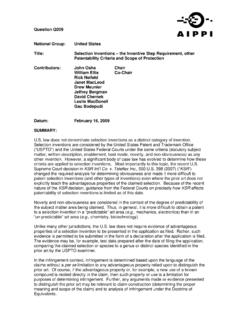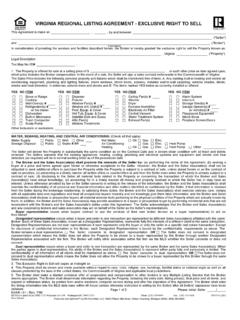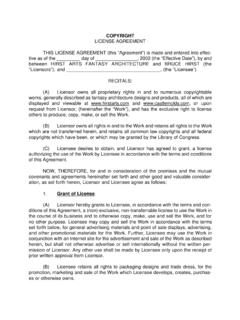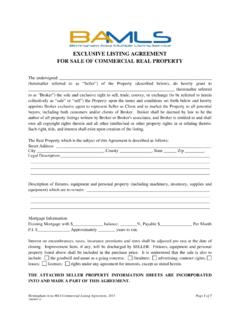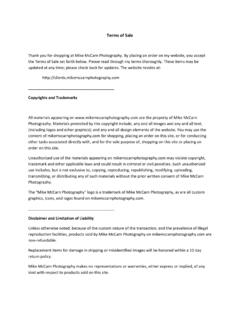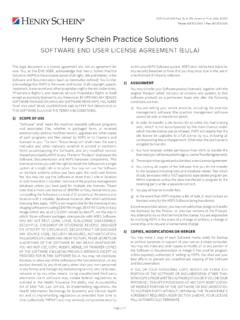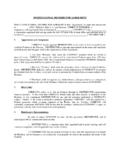Transcription of Report of United States Group of AIPPI Question …
1 99988/2455 07/14/2008 Report of United States Group of AIPPI Question Q205 Exhaustion of IPRs in cases of recycling and repair of goods The United States responses were prepared by: David W. Hill Vanessa A. Ignacio Plymouth D. Nelson Jeffrey E. Danley Questions I. Analysis of the current statutory and case law 1. Exhaustion In your country, is exhaustion of IPRs provided either in statutory law or under case law with respect to patents, designs, and trademarks? What legal provisions are applicable to exhaustion? What are the conditions under which an exhaustion of IPRs occurs? What are the legal consequences with regard to infringement and the enforcement of IPRs? Patents: The doctrine of exhaustion of patent rights has no direct statutory origin but rather was developed by the courts and premised on a patentee s basic right to exclude others from making, using, selling, offering to sell, or importing the patented invention.
2 Accused infringers typically raise exhaustion as an affirmative defense in the context of downstream use of a licensed Patent exhaustion, though seemingly simple in scope, has proven complex in In a series of mid-nineteenth century cases, the Supreme Court initially acknowledged that a patent holder s rights could be exhausted through lawful purchase of the patented product. In Adams v. Burke, the Court succinctly noted that when a patentee sells an article whose sole value is in its use, he receives the consideration for its use and he parts with the right to restrict that use. 3 The Supreme Court further defined this concept, also known as the first-sale doctrine, seventy years later in United States v. Univis Lens Co.: 1 See, , Monsanto Co. v. Scruggs, 459 1328, 1333-36 (Fed. Cir. 2006).
3 2 The answers to questions 1-11 of this section have been prepared in view of the current state of the case law governing the patent-exhaustion doctrine in the United States . Currently, the Supreme Court is reviewing the Federal Circuit s 2006 decision in LG Electronics, Inc. v. Bizcom, Inc., which may significantly affect the patent-exhaustion landscape. The Court s forthcoming decision, Quanta Computer, Inc. v. LG Electronics, Inc., may require amendment of the answers to questions 1-11 to properly reflect any changes in law. 3 84 453, 456 (1873). -2- An incident to the purchase of any article, whether patented or unpatented, is the right to use and sell it, and upon familiar principles the authorized sale of an article which is capable of use only in practicing the patent is a relinquishment of the patent monopoly with respect to the article sold.
4 The full extent of the monopoly is the patentee s .. exclusive right to make, use, and vend the invention or discovery. The patentee may surrender his monopoly in whole by the sale of his patent or in part by the sale of an article embodying the invention. His monopoly remains so long as he retains the ownership of the patented article. But sale of it exhausts the monopoly in that article and the patentee may not thereafter, by virtue of his patent, control the use or disposition of the In this seminal case , the defendant, having several patents with claims for finished lenses, manufactured lens blanks, using three types of licensees to finish and distribute the product. The defendant collected a royalty only from the first sale to the first licensee, but attempted to impose price-fixing parameters on the downstream licensees. While the case was appealed based on violations of the Sherman Antitrust Act, the Supreme Court decided the case using principles of patent exhaustion developed in the prior century.
5 The Court remained mindful of the antitrust relationship, declaring, the patentee cannot control the resale price of patented articles which he has sold, either by resort to an infringement suit, or, consistently with the Sherman Act .. by stipulating for price maintenance by his vendees. Id. at 250. Of great significance was the Court s determination that the lens blanks, sold only to licensees who would finish the product, embodied essential features of the patented device: [W]here one has sold an uncompleted article which, because it embodies essential features of his patented invention, is within the protection of his patent, and has destined the article to be finished by the purchaser in conformity to the patent, he has sold his invention so far as it is or may be embodied in that particular article. The reward he was demanded and received is for the article and the invention which it embodies and which his vendee is to practice upon it.
6 He has thus parted with his right to assert the patent monopoly with respect to it and is no longer free to control the price at which it may be sold either in its unfinished or finished The Court ruled that the defendant exhausted its patent rights on its first sale (or, alternatively, the first sale by licensees who manufactured the lens blanks) and could not control later sales. As defined by the Court, the patent-exhaustion doctrine therefore applies not only to the sale of patented articles, but also to the sale of 4 316 241, 249-50 (1942). 5 Id. at 250-51 (emphasis added). -3- unpatented items having an essential feature of the final patented item and no other use except in the final patented item. While the definition of essential feature was not clearly stated in Univis Lens, the Federal Circuit provided further meaning to this term by stating that a feature of a patent claim that distinguished over the prior art was an essential In other words, an unpatented article containing this type of feature, when sold, may subject a patented combination or finished product, of which it is a part, to patent exhaustion.
7 The Federal Circuit has distinguished between apparatus and method claims in the context of patent exhaustion, though such a distinction appears no longer necessary. The doctrine that the first sale by a patentee of an article embodying his invention exhausts his patent rights in that article .. is inapplicable here, because the claims of the [patent] are directed to a method of retreading .. 7 In an ostensibly contradictory statement, the court also declared, The defense of repair is applicable to process claims, as well as to apparatus claims, when the patented process was used in the United States and the patent right has been exhausted for the articles produced thereby. 8 No discernible reason exists to limit the doctrine to apparatus claims. Although a patentee exhausts his or her rights at the first sale, the exhaustion doctrine is not pertinent unless that sale is unconditional, since private parties remain free to contract concerning conditions of sale.
8 9 Of course, to be conditional for purposes of the doctrine, any restriction must be lawful, , the conditions cannot violate antitrust laws or constitute other types of patent As a license is a contract, lawfulness also requires any conditions be subject to applicable laws of contract and include any relevant equitable Any condition must also be expressly set While licenses containing restrictions that violate laws or equitable considerations are not enforceable, violations of valid license conditions allow the patentee to seek action for patent infringement or breach of In sum, an express condition is enforceable through contract as a patent right as long as it is lawful, , does not violate antitrust provisions or broaden the patent scope with anticompetitive effect. 14 Any restriction of competition so scrutinized by the court will be subject to the rule of While an action for patent infringement lies within the federal courts exclusive jurisdiction, licenses are enforced through an individual state s contract laws at the state level, unless diversity of citizenship gives rise to federal jurisdiction.
9 6 Cyrix Corp. v. Intel Corp., 846 F. Supp. 522, 534 ( Tex. 1994), aff d, 42 1411 (Fed. Cir. 1994). 7 Bandag, Inc. v. Al Bolser s Tires Stores, Inc., 750 903, 924 (Fed. Cir. 1984). 8 Jazz Photo Corp. v. Int l Trade Comm n, 264 1094, 1108 (Fed. Cir. 2001). 9 Mallinckrodt, Inc. v. Medipart, Inc., 976 700, 708 (Fed. Cir. 1992). 10 Id. 11 B. Braun Med., Inc. v. Abbott Labs., Inc., 124 1419, 1426 (Fed. Cir. 1997). 12 Id. 13 Id. 14 Id. 15 Mallinckrodt, 976 at 708. -4- Concerning design patents, the Federal Circuit has declared, [T]he principle of exhaustion applies to the design patents as well as to the utility patents. The design patent right, like all patent rights, is exhausted by unrestricted first sale in the United States , and is not infringed by the importation and resale of the repaired articles in their original design.
10 16 Thus, the doctrine of patent exhaustion is equally applicable to design patents. Trademarks: The Trademark Act of 1946 (the Lanham Act )17 contains no reference to the principle of exhaustion. Rather, exhaustion is a concept derived from case law and applied by the courts, typically raised as a defense in claims of trademark infringement in which the defendant has resold or distributed a genuine good bearing the trademark of A defendant's successful application of the exhaustion rule depends on whether the goods in Question are genuine; at its most basic level, the exhaustion rule permits the resale of genuine branded goods without liability for trademark infringement. Within this context, the word "genuine" is a term of art. Proper use of this term requires an examination of (1) whether the trademark owner had adequate control over the goods before their entry in the market and (2) whether the goods were materially different from other goods sold under the same mark.
